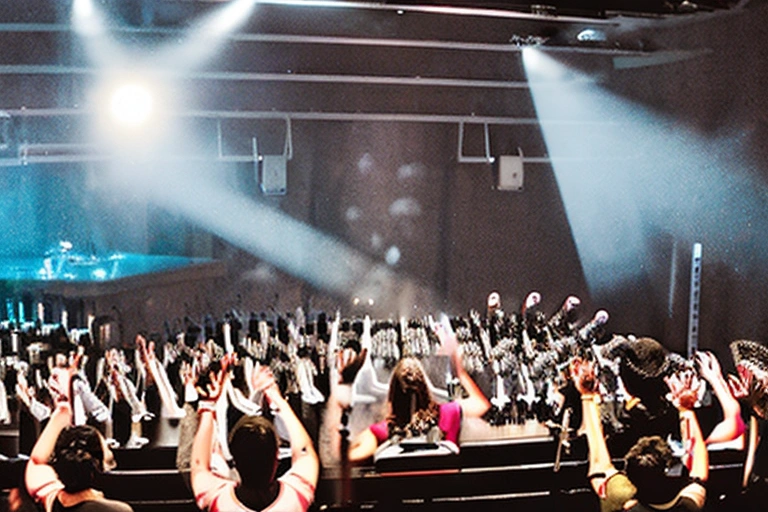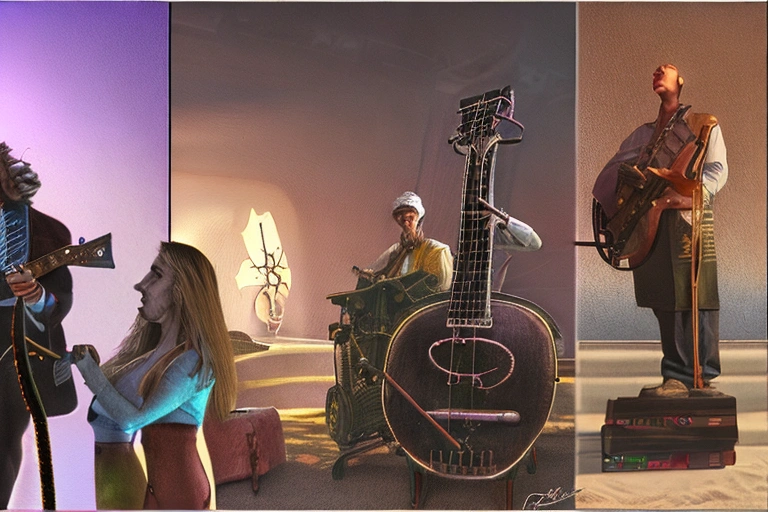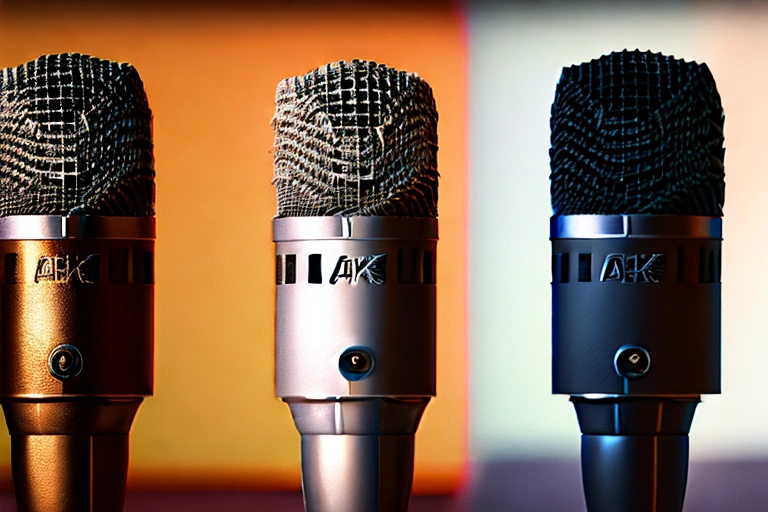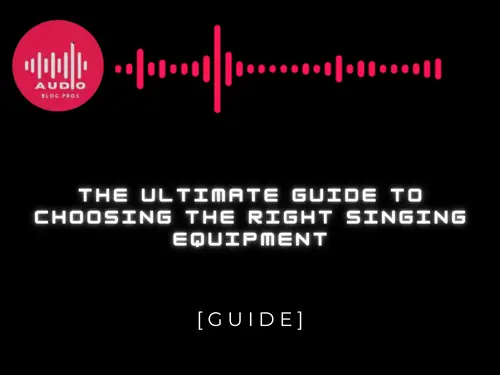Are you a singer looking to take your skills to the next level? Are you ready to invest in the best singing equipment but don’t know where to start? Are you wondering about the Equipment Needed For Live Singing? Look no further! This blog post will provide all the information you need to ensure you get the perfect set-up for your voice and style. Keep reading for an ultimate guide on choosing the right singing equipment!
- Microphone Selection
- PA System Considerations
- Sound Re-enforcement Equipment
- Powering Your Sound System
- Windproof Shields for Outdoor Gigs
- Types of Monitors Available
- Music Stand Options For Singers
- Essential Accessories for Live Performances
- Enhancing the Acoustic Environment on Stage
- Lighting Solutions to Enhance Your Performance
- Working With A Professional Sound Engineer
- Troubleshooting Common Problems with Audio Equipment
Microphone Selection
Regarding microphone selection, there are a few things to keep in mind. The type of microphone you choose will largely depend on the singing you plan to do. For example, if you want to sing in a choir or band, you’ll need a cardioid microphone. This microphone captures sound directly, which is perfect for group singing.
If you only plan to record your voice, a condenser microphone will work fine. These microphones are more sensitive and can pick up more detail than a cardioid mic. However, they can also be more expensive.
Another factor to consider is the price range of the microphone. Some microphones, like the Shure SM57, are affordable, while others, like the AKG C414B-ULS, are a bit more expensive. Finding a microphone that fits your budget and meets your needs is essential.
Once you’ve selected the type of microphone and price range that works best for you, it’s time to choose the suitable mic stand. A good mic stand will provide stable support for your microphone and make it easier to record high-quality audio. Some stands come with adjustable height options, which is excellent for different singers with different heights.
Finally, test your new microphone and mic stand before recording your first song!

PA System Considerations
When choosing the right PA system for live singing, there are a few key factors to consider.
First and foremost, your venue’s acoustic properties will dictate what type of PA system is needed. If your hall or stage is particularly acoustically sensitive, you may want to opt for an electronic audio mixing panel (AEP) instead of a conventional PA system. Conversely, a regular PA system should do the trick if your venue is relatively forgiving – or you simply don’t want to deal with all the setup headaches.
In addition to acoustic properties, the output power is another factor worth considering when selecting a PA system for live singing. While most venues require at least 8 watts of output power per channel, more powerful systems can handle even higher volumes without distortion. Finally, ensure to account for cable length when selecting your gear; many stages have minimum distances between speakers and monitors that must be met to avoid audio crosstalk.
Once all these factors have been considered, you can begin shopping for your dream PA system!

When planning an outdoor gig, it is essential to consider the weather conditions. Windproof shields can help keep singers and musicians safe in high winds.

Sound Re-enforcement Equipment
Live singing can be a beautiful experience, but it can also be quite demanding on the vocal cords. To get the most out of your performance, equip yourself with the right singing equipment. Here are some of the most important items you’ll need:
- A windproof shield.
- A microphone.
- A headset or earbuds.
- A singing stand or stool.
- A tuner or metronome.
- A lip balm or chapstick.
- A water bottle or cup.
- Sunscreen and lip balm for outdoor gigs in the summertime!
Powering Your Sound System
Assessing Your Personal Needs
No matter how experienced you are, there will always be room for improvement in your singing. For this reason, it is important to equip yourself with the right sound reinforcement equipment to help boost your performance.
Below is a list of various items that are necessary for live singing:
- Microphones: A good microphone will help pick up your voice clearly and evenly, regardless of the acoustic environment or noise level. There are many types of microphones available on the market, so it is essential to find one that best suits your needs and expectations.
- Speakers: Your audio speakers will disperse the sound frequencies coming from your microphone so that everyone in attendance can hear you clearly. The type of speaker you choose will depend on the size of the room, the quality of your microphone, and your budget.
- Headphones: If you are using a microphone and speakers, it is essential to have headphones to protect your ears from loud noises. Over-the-ear headphones are generally the best type to use, as they will provide more protection from noise.
- Mixer: A good mixer will allow you to control all sound settings in your live performance environment. This will help you to create a balanced and consistent sound for all attendees.
- Amplifier: An amplifier is necessary if you want to achieve a high volume level for your performance. Make sure to get an amplifier powerful enough to handle the sound levels you will be playing at.
- Power Supply: You will need a power supply to power all your equipment. This can be a battery or an outlet.
Windproof Shields for Outdoor Gigs
Once you have gathered the necessary items, it is time to assess your personal needs and expectations. Do you want to use a microphone that is attached to your instrument, or do you want to use a separate microphone? Do you want to use speakers on either side of you, or do you want to use headphones? Once you have answered these questions, finding the right equipment for your live singing performance is more accessible.
Considering Your Budget
Budget is one of the most important factors to consider when powering your sound system. Depending on the type and quality of equipment you are looking to purchase, your budget can range from a few hundred dollars all the way up to several thousand dollars. Before making any decisions, it is essential to understand how much power and amplification you need for each type of application.
For example, if you plan on using a vocal booth for live performances or recording vocals in a studio, a small PA system will be sufficient. However, if you want to use your sound system for larger stage productions or events, you will likely need more power and amplifier capability. Additionally, certain audio frequencies may require more amplification than others to be heard, depending on your venue and preference.
When purchasing, it is essential to keep these various factors in mind and buy the equipment that best suits your needs. Ultimately, ensuring a good sound quality for any performance or event is impossible without the proper equipment.
Researching the Options
The right singing equipment can make or break a performance. There are several factors to consider when choosing the right equipment, including the type of music you will be singing, your vocal range, and the size of the venue.
Sound reinforcement equipment is essential for live singing but is not the only factor to consider. You also need to research the options available and choose the best equipment for your needs.
Several different types of sound reinforcement equipment are available, from PA systems to microphones. You’ll need to decide which equipment is best for your performance and audience.
PA systems are suitable for larger venues and can provide good sound quality. They’re also easy to set up and use, which is a plus for many singers.
Microphones are suitable for smaller venues and can capture the sound of your voice more accurately. They’re also usually less expensive than PA systems, so they may be a better option if you don’t have much money to spend on equipment.
To get the best performance from your singing equipment, it’s essential to research the options available and choose the right equipment for your needs.
Testing and Evaluating Products
Once you have chosen the right singing equipment, it’s time to test it out! There are a few different ways to do this. First, sing in a comfortable environment without any sound reinforcement. This is essential because you will want to ensure your equipment sounds acoustically good before using it in a live setting.
Second, use your equipment to reproduce acoustic recordings of well-known songs. This will give you an idea of how the playback system handles high-quality audio files. Finally, try out your new gear at a popular music venue and see how it sounds against other performers on the bill. Doing this can help determine if the equipment provides the appropriate balance between quality and noise for your performance.

Types of Monitors Available
Various types of monitors are available for singers, and it can be challenging to decide which is right for you. Here are some of the most common types:
A live vocal performance can be significantly enhanced by using a good monitor. Monitors can be used to check the quality of your voice, to help you hear how you sound in different situations, and to help you improve your singing technique.
Various types of monitors are available, and deciding which is right for you can be challenging. Here are some of the most common types:
A dynamic microphone is a type of microphone that uses a diaphragm to produce sound. Dynamic microphones are usually used in recording studios because they have a clear signal that can be easily heard. They are not usually used in live performances because they do not produce a loud enough signal.
A condenser microphone is a type of microphone that uses a capacitor to produce sound. Condenser microphones are usually used in live performances because they have a louder signal than dynamic microphones. They are also usually more expensive than dynamic microphones.
A ribbon microphone is a type of microphone that uses a ribbon to produce sound. Ribbon microphones are usually used in live performances because they have a warm sound that is popular with some singers. They are also usually more expensive than other types of microphones.

Music Stand Options For Singers
A music stand is an essential piece of equipment for singers. There are various options available, so it’s essential to choose the right one for your needs.
When choosing a music stand, you must consider the type of singing you plan to do. You’ll likely need a tall music stand with a wide base if you’re primarily a classical or opera singer. If you’re a pop or rock singer, you’ll likely need a shorter music stand with a narrower base.
Another important factor to consider is the type of microphone you plan to use. Using a dynamic microphone, you’ll need a music stand with a shock-mount system. If you’re using an electret microphone, you won’t need a music stand with a shock-mount system, but one with a ¼” input jack.
Finally, consider the size of your ensemble. If your ensemble consists of only one singer, you can probably use any music stand. If your ensemble consists of more than one singer, it’s essential to choose a music stand that can accommodate all of them.

Essential Accessories for Live Performances
Live singing can be a very rewarding experience, but it requires the right equipment in order to make the most of it. Here is a guide to choosing the right singing equipment, based on your needs and preferences.
Music Stand Options For Singers
If you’re just starting out or in college and don’t have your own recording studio yet, then a music stand may be all you need for live performances. Various options are available, so find one that’s comfortable for you and has enough height for you to reach the highest notes comfortably. The best stands come with adjustable height and angle so that you can customize them to fit your performance style.
Investing in an acoustic guitar may be a good idea if your career ambitions include performing on stage at major concerts or festivals. Acoustic guitars play well indoors or outdoors thanks to their portability – this means they can travel easily between gigs. An electric guitar might also work well for live performances (especially if you have experience playing in front of people). Still, acoustic guitars are often favoured because they create a more natural sound when played live.
You’ll also need some accessories for live performances: microphone stands or boom poles (for voice-over recordings), instrument cables (to connect your instruments to the PA system), and headphones (to help block out ambient noise). You can purchase these items separately or as part of an audio kit designed specifically for live performers – like Guitar Center’s GC LIVE! Collection .
Enhancing the Acoustic Environment on Stage
Evaluating Your Needs
While various acoustic equipment options are available to singers, the most important factors to consider when choosing live singing equipment include the singer’s voice type, audience size, and venue. Different pieces of acoustic equipment will have different effects on each vocal kind and the size of the audience. Some singers may prefer smaller or more intimate settings, while others may prefer larger venues with a more general acoustic audience.
Regardless of the setting, it is essential that any singer evaluates their needs to find the right audio and lighting configuration for themselves and their performance.
There are a few essential pieces of audio and lighting equipment that every singer should have regardless of the type or size of performance: a microphone, amplifier, speakers, and headphones. Microphones come in wide different varieties with prices starting at around $50. Some singers may prefer a dynamic microphone for its noise-cancelling properties or for capturing higher-pitched voices, while others might choose an electret condenser mic for its neutrality.
Amplifiers also vary greatly in price and feature set, but all amplifiers will boost the signal from your microphone so that it is loud enough to be heard by the audience. Many singers opt for small amplification systems known as “plug-ins”, which can be connected directly to their laptop or mixing board. Portable amps are also available, which can be easily transported to different venues.

Speakers are the most essential part of any acoustic system, and it is crucial to select the right size and type for your performance. Smaller speakers can be placed on either side of the singer or on a stand in front of them, while larger speakers can be placed on either side of the stage or at the back of the room.
When selecting speakers, it is important to consider the size and type of venue and the sound quality you are looking for.
Headphones are an essential part of any singer’s audio arsenal and should be chosen based on the type of performance that they are doing. Closed-back headphones will help to isolate the singer from external noise, while open-back headphones will allow the audience to hear the singer’s voice better.
Headphones should also be chosen based on the size and type of venue that the performance is taking place in. Large venues require headphones with a high-output capacity so that the singer can be heard over the crowd, while smaller venues may only require closed-back headphones.
To evaluate the necessary acoustic equipment for a live performance, it is essential to first determine what type of vocalist you are and what kind of performance you are trying to achieve. After selecting your audio and lighting equipment, it is essential to familiarize yourself with your surroundings by tuning into your sound check or preparing some test phrases ahead of time. By following these simple tips, every singer can improve their acoustic environment and create a better performance.
Understanding the Different Types of Equipment
Live singing performances can be enhanced by using the right singing equipment. There are a variety of different types of equipment that can be used to improve the acoustic environment on stage. This includes microphones, vocal booths, sound systems, and other audio equipment.
Microphones
Microphones are the most critical piece of singing equipment. They are used to capture the sound of the singer’s voice and send it out to the audience. There are various types of microphones, each with its own advantages and disadvantages.
The most common type of microphone is the cardioid microphone. This microphone captures sound in a directional manner, meaning that it will only pick up sound from directly in front of it. This is the type of microphone that is usually used for vocals.
The disadvantage of the cardioid microphone is that it can be challenging to capture the sound of a singer’s voice in a room with a lot of ambient noise. This is why it is often used in conjunction with other microphones, such as the omnidirectional microphone.
The omnidirectional microphone captures sound from all directions equally. This is the type of microphone that is usually used for recording music.
Another type of microphone commonly used for live singing performances is the lavalier microphone. This microphone is small and unobtrusive and can be attached to the singer’s clothing or collar.
The advantage of the lavalier microphone is that it is easy to use, and it can capture the sound of the singer’s voice in a room with a lot of ambient noise.
Vocal Booths
A vocal booth is a room specifically designed to improve the acoustic environment on stage. This is because vocal booths have walls specially designed to absorb sound. This means that the sound of the singer’s voice will be more consistent and clear.
Vocal booths are usually rectangular or square in shape, and they come in a variety of different sizes. They can be used with other types of microphones, such as the lavalier microphone.
Sound Systems
Sound systems are devices used to amplify the sound of the music being played. They come in various shapes and sizes, and they can be used to play the sound of the music either live or in stereo.
A common type of sound system that is used for live singing performances is the PA system. This large, box-shaped sound system is usually placed on stage behind the singer.
The advantage of using a PA system is that it produces loud and clear sound. However, it can be difficult to mix the sound of the vocals with other instruments onstage. This is why it is essential to use vocal booths and other audio equipment in conjunction with a good sound system.
Finding the Right Fit for Your Voice
When choosing the right singing equipment, you must consider the acoustic environment in which you will perform. This means finding the right fit for your voice and ensuring that the equipment you choose is able to amplify your sound without adding too much noise or distortion.
There are several different pieces of singing equipment that can be used to improve the acoustic environment on stage. Choosing the right one for your voice is essential, as not all parts of the equipment are created equal.
One standard piece of singing equipment used to enhance the acoustic environment on stage is a microphone. Microphones are small devices that are placed in front of your mouth and capture your voice. They can be used to amplify your sound, making it easier for other people to hear you.
Microphones come in various sizes and shapes, and it is essential to find one compatible with your voice. Some microphones are designed for singers with a soprano or alto range, while others are more suited for voices in the middle or high fields. It is essential to test out different microphones to see which ones work best for your vote.
Another standard piece of equipment used to enhance the acoustic environment on stage is an audio mixer. An audio mixer is a device that allows you to control the volume of various sound sources on stage. This can be helpful if you want to adjust the level of your vocal sound without taking away from other sound sources on stage.
It is essential to find an audio mixer that is compatible with the type of microphone and sound source you are using. Some mixers have multiple input channels, which allows you to connect various microphones and sound sources at the same time.
If you are planning on using a microphone and audio mixer, it is essential to find a compatible pair. Some mixers have cables specific to certain types of microphones, so it is essential to ensure the mixer you choose has the lines you need.
Another standard piece of equipment used to enhance the acoustic environment on stage is a PA system. A PA system is a device that amplifies your voice and sends it out over the background so that other people can hear you.
PA systems come in various sizes and styles, and it is essential to find one compatible with the type of acoustic environment you are performing in. Some PA systems are designed to be placed on stage, while others are intended to be used in a studio setting.
It is essential to find a PA system compatible with the microphone and audio mixer you are using. Some PA systems have inputs that allow you to connect multiple microphones and audio mixers simultaneously.
If you are planning on using a microphone and audio mixer, it is essential to find a compatible pair. Some mixers have cables specific to certain microphones, so you must ensure the mixer you choose has the needed lines.
When choosing the right singing equipment, you must consider the acoustic environment in which you will perform. This means finding the right fit for your voice and ensuring that your chosen equipment can amplify your sound without adding too much noise or distortion.
Several pieces of singing equipment can be used to improve the acoustic environment on stage. Choosing the right one for your voice is essential, as not all equipment parts are created equal.
One standard piece of singing equipment used to enhance the acoustic environment on stage is a microphone. Microphones are small devices placed in front of your mouth and capture your voice. They can be used to amplify your sound, making it easier for other people to hear you.
Microphones come in various sizes and shapes, and it is essential to find one compatible with your voice. Some microphones are designed for singers with a soprano or alto range, while others are more suited for voices in the middle or high fields. It is essential to test out different microphones to see which ones work best for your vote.
Another standard piece of equipment used to enhance the acoustic environment on stage is an audio mixer. An audio mixer is a device that allows you to control the volume of various sound sources on stage. This can be helpful if you want to adjust the level of your vocal sound without taking away from other sound sources on stage.
It is essential to find an audio mixer that is compatible with the type of microphone and sound source you are using. Some mixers have multiple input channels, which allows you to connect various microphones and sound sources at the same time.
If you are planning on using a microphone and audio mixer, it is essential to find a compatible pair. Some mixers have cables specific to certain microphones, so you must ensure the mixer you choose has the needed lines.
Making an Informed Decision
Live singing performances can be compelling experiences, but they can also tax the performer. To create the perfect acoustic environment for their voice, singers need the right equipment.
Singers need a few critical pieces of equipment to make their performances sound their best. The microphone is essential for capturing the singer’s voice and giving it a natural sound. A good microphone will also have a good pickup pattern, which means it can capture all of the vocal frequencies.
A good amplifier is also essential for live singing. An amplifier will help to boost the volume of the singer’s voice, making it easier to be heard over the crowd. It is also essential to choose an amplifier with a good frequency response, which can cover a wide range of frequencies.
Having the right microphone stand is also essential if the singer plans to use a microphone. A good microphone stand will help to keep the microphone in line with the singer’s mouth, minimizing disturbance in the sound recording process.
If acoustic excellence is what the performer desires, they will need to invest in quality earplugs and noise-cancelling headphones. Ear plugs are essential for blocking distractions while singing, while noise-cancelling headphones can help reduce background noise levels so that focus is not lost during performance.
Lighting Solutions to Enhance Your Performance
There are a few key factors to consider when selecting the proper lighting for your live singing performance.
First, you’ll need to decide what performance you’re aiming for. Are you looking to showcase your vocal abilities in a traditional concert setting? Or are you hoping to create a more intimate and personal performance for your fans?
Second, you’ll need to decide what type of lighting you want to use. Do you want to use traditional stage lighting, or do you want to incorporate some light effects into your performance?
Third, you’ll need to decide how much lighting you need. Do you only need a few essential lights, or do you need an entire lighting rig?
And finally, you’ll need to decide where to put the lights. Will they be positioned on the stage, or will they be placed around the audience?
Working With A Professional Sound Engineer
Identifying Your Needs
When working with a professional sound engineer, it is essential to identify your needs and have the correct equipment to achieve the desired sound. This can include microphones, audio cables, good boards, and mixers.
Microphones are essential for capturing the voice of the singer. It is crucial to choose a microphone that is suited for the type of performance you are doing. For example, a dynamic microphone is best for live performances where the singer moves around a lot. On the other hand, a condenser microphone is better for recording vocals in a studio setting.
Audio cables are necessary to connect the microphone to the sound board and mixer. It is essential to choose lines that are compatible with your equipment. For example, if you are using a microphone and soundboard from a different manufacturer, you will need to use an audio cable that is compatible with both.
Sound boards are devices that convert the electrical signals into audible sounds. They come in different shapes and sizes and can be attached to the wall or floor of the performance space. They are also available as stand-alone units.
Mixers combine multiple audio sources (microphones, sound boards, etc.) into one cohesive output. They come in various configurations (e.g., mono or stereo), and can also include effects such as distortion and reverb.
Overall, working with a professional sound engineer is important if you want your singing performance to be of the highest quality. By having the correct equipment and working with a sound engineer who understands your needs, you can achieve the perfect sound for your performance.
Researching Different Types of Equipment
One of the most essential aspects of sound engineering is knowing which equipment to use and in what order to achieve the desired sonic outcome. Singers must know what kind of hardware can be beneficial for their performance, as well as how best to work with a professional sound engineer to get the best results.
Here are some essential pieces of equipment that every singer should consider:
- Monitors: Every singer requires at least one monitor to ensure they hear themselves correctly during performances. When choosing monitors, it’s crucial to note that size doesn’t matter as much as type (i.e., studio monitors or live drums). While home studios may not always require high-end studio monitors, a singer will likely need something more robust for live performance.
- Recording Equipment: A professional sound engineer will often require a singer to register their performance to assess the quality and finesse of their singing. This can be done through various recording devices, such as a digital recorder, audio interface, or even a cassette deck.
- Mixers: One of the critical roles of a professional sound engineer is to mix the vocal tracks with accompanying instruments/sound effects to create an overall sonic mix. Mixers come in different types (analogue and digital), and costs range based on features and specifications. Singers must select the suitable mixer for their needs to achieve the desired sonic outcome without worrying about technical details.
- Acoustic Noise-Cancelling Headphones: Acoustic noise-cancelling headphones are essential for singers who frequently perform in noisy environments, such as live performances or recording studios. By blocking out external noises, singers can focus on their performance without distraction.
- Room Mics: Room mics provide a direct ‘in the room’ sound source for vocals and can be particularly beneficial for singers who want to capture natural-sounding vocals. While they can be more costly than other microphones, they’re often worth the investment, given their unique ability to capture true audio intimacy.
Evaluating Quality and Price
A good quality microphone is an essential piece of equipment you’ll need to successfully sing live. A great mic will capture your voice beautifully without distortion or unwanted noise. You can also get great microphones that are portable and easy to use. However, not all mics are created equal, and choosing one that is right for you and your performance style is essential.
When choosing a microphone, evaluate the quality and price of options available. It’s important to remember that not all mics are created equal – some may be more expensive but provide better sound quality than less expensive options. It’s also important to remember that you may want different features depending on the type of music you’re singing. For example, you may want a more powerful microphone for pop and rock music than you would for classical or gospel.
Discuss your specific performance needs and desires when working with a sound engineer. A sound engineer can guide the selection of the best equipment for your performance, helping to ensure that everything comes together smoothly and sounds fantastic!
Making Your Final Decision
If you are serious about singing, you must work with a professional sound engineer. A good engineer can help you improve your sound, record your vocals correctly, and provide other support during your performance.
When choosing a sound engineer, it is essential to consider their experience and expertise. Look for someone who has worked with a variety of singers and music styles. Additionally, be sure to ask for references. Once you have chosen a sound engineer, be sure to work closely with them throughout the recording process.
Troubleshooting Common Problems with Audio Equipment
If you’re having trouble with your audio equipment, there are a few things you can do to troubleshoot the problem. First, ensure that all your audio cables are plugged in correctly and that your audio equipment is turned on. If you’re still having trouble, try resetting your audio equipment by turning it off and back on. You may need to take it to a professional if that doesn’t work.
Live singing is an incredible way to express yourself and engage your audience. With the right equipment, you can ensure that everyone involved in your performance has a great experience. From sound re-enforcement systems to music stands, many pieces of gear are needed for live singing – we’ve provided an overview of these components so that you can make the best choices for your needs.
We hope this guide has been helpful as you plan out what equipment is right for you! For more tips and advice on performing live, check out our other content here at https://audioblogpros.com.


